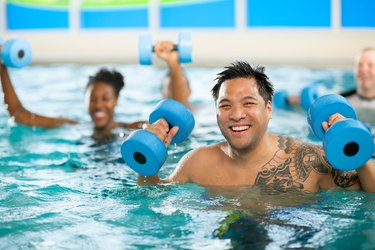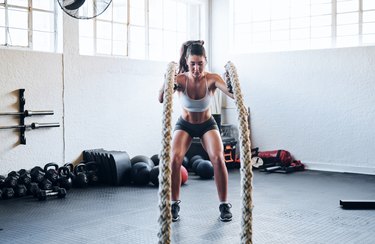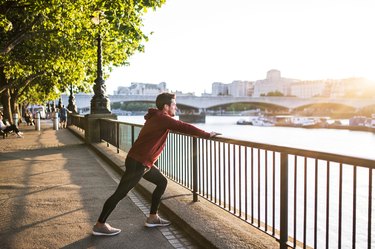
If the treadmill or elliptical doesn't appeal to you, don your swimsuit. Water aerobics, or aqua fitness exercise, is a great workout for a wide range of people, but it's particularly beneficial for older adults and those who don't want to put a lot of stress on their joints.
Water aerobics classes usually take place in swimming pools and use music to make workouts fun. Instructors might stand up on deck, demonstrate moves or join students in the water. Deep-water aerobics requires the use of special flotation belts to provide stability and buoyancy.
Video of the Day
Video of the Day
Colorado-based water aerobics instructor Angela Ruest has taught aqua fitness for more than 20 years and is currently a Life Time instructor in the ARORA program, which focuses on helping older adults stay active as they age.
"There are actually multiple types of water aerobics classes," Ruest says. "Aqua Zumba and water yoga are great for strength training while deep aqua walking or jogging is more focused on cardio."
Most fitness centers offer a brief description of the water aerobics class so you know if it is more strength- or cardio-based before taking part. No matter whether a strength- or cardio-based program appeals to you, there are some universal benefits of water aerobics for people of all ages.
10 Benefits of Water Aerobics
1. It's Low-Impact
Ruest's top benefit of water aerobics is that it is easy on the joints.
A March 2022 review in Healthcare found that water aerobics helped people with osteoarthritis and people with overweight find relief from stress on their joints.
The study found that the buoyancy of water supports the weight of the body, reducing impacts on joints and the intensity of pain.
2. Water Aerobics Builds Community
Ruest frequently sees how water aerobics helps to build community and gets older adults out of their home and into interactive social situations.
A March 2021 study in PLOS One, conducted by the Center for Healthy Aging at Penn State University, found that socializing may improve older adults' cognitive function in daily life.
Water aerobics classes can be a fantastic opportunity to get out of the house and meet some new friends and members of the local community, and exercising with friends makes exercising more fun — which often keeps people engaged and more consistent.
3. You Get Mental Stimulation
Not only is water aerobics a physical workout, it also works out your brain.
Learning how to do a series of movements for a routine can help form new neural pathways in the brain, which is key to maintaining a healthy brain as one ages.
A small July 2018 study in PLOS One found that aging adults who participated in a six-month-long dance program that involved learning choreography developed not only physical fitness, but increased the volume of their grey matter as well, which is one way to measure brain health and activity.
Although water aerobics is slightly different than dancing, attendees still must learn the class choreography, just like in dancing. Water aerobics also challenges the mind to quickly learn the workout steps and then repeat them in the order the instructor presents them in.
4. You Get a Full-Body Workout
"Depending on the type of class and water depth, water aerobics really is a full-body workout," Ruest says.
Aqua fitness involves using the entire body (and mind). You may aqua jog or walk as part of the movements, using your legs and core for stability. Water weights or above-water hand motions are likely to be part of the workout routine, as well.
5. You Build Cardiovascular Fitness
Water aerobics is a highly cardiovascular activity. It gets you breathing hard and elevates your heart rate as you move through the workout.
Regularly participating in water aerobics classes can help improve your body's tolerance for a higher heart rate and cardiovascular expenditure, ultimately leading to increased cardiovascular fitness.
In turn, improved cardiovascular fitness will help you in daily life, like with climbing stairs, going for walks, riding a bike or cleaning and gardening.
6. It Serves as Cross-Training
Even if your main athletic interests are elsewhere, like pickleball or cycling, water aerobics is the perfect cross-training option to complement your other fitness activities.
Because water aerobics is easy on the joints but provides a high level of resistance, water aerobics can help your joints heal after impactful activities while still encouraging your muscles to activate and get in a workout.
Plus, water aerobics may use different muscles than your other fitness activities, which gives other parts of your body a break and encourages you to leverage different muscles and thinking patterns.
7. You Build Core Strength
As we age, our core strength may decline if we become sedentary. However, core strength is key for daily functions such as keeping our balance when walking, moving from sitting to standing or climbing the stairs.
Properly executing water aerobics movements forces the body to activate its core to keep you balanced and stable in the water. The extra resistance from the water also activates your core in order to perform each move, too.
8. It Can be a Recovery Workout
Similar to how water aerobics can be an opportunity to cross-train for other fitness activities, water aerobics can also help you wind down from your other recent workouts.
Water yoga especially can be an extra-relaxing way to connect to your body, breath and mind. Thanks to the buoyancy of the water, aqua yoga can make even difficult poses or yoga movements a bit easier because you feel weightless in the water.
9. It Improves Mobility and Flexibility
Water aerobics provides a low-risk environment for you to move your body. Some of the movements may involve bending toward your toes, reaching behind you to stretch your quads or reaching upward to stretch your back and arms.
Even if you stumble or lose your balance during a stretch, the water makes for a soft landing, meaning it is OK to practice your mobility in water aerobics.
The weightlessness effect of the buoyancy of water can make stretching and mobility movements feel less constrained and laborious, as well.
10. The Water Feels Nice
Most water aerobics classes are done in heated therapy pools. The heat helps to loosen the joints and relax the muscles. For those who struggle with joint aches or mobility challenges, the water itself is therapeutic.
Other aqua fitness classes may be held in cooler lap pools. The cold water can have an anti-inflammatory effect on those who are challenged with arthritis or achey muscles.
5 Drawbacks of Water Aerobics
1. It Minimizes Gravity's Effect
The downside of the low-impact nature of water aerobic exercise is that it does little to build strong bones or lean muscle mass efficiently. Water's ability to make you feel weightless can be soothing for the joints and body, but it means that you miss out on building other key fitness foundations.
Weight-bearing exercise builds both bones and muscles. Because water minimizes the effects of gravity and weight, water aerobics is not the best exercise for that purpose.
"Water minimizes the effects of gravity," Ruest says. "Therefore, it does little to help build strong bones; only weight-bearing exercises can do this."
In order to fully benefit from water aerobics, you may want to consider adding in some weekly weight-bearing exercises such as balance work, using dumbbells or working with a personal trainer.
2. Decreased Calorie Burn
Although water aerobics is a great fitness activity, it does not burn as many calories as other, more intense forms of cardio.
"Water aerobics does burn calories, but not as many as other exercise options," Ruest says. "A 155-pound adult can burn roughly 300 calories in an hour of water aerobics, while the same adult would burn about 900 calories running on the treadmill at 7.5 mph for an hour."
However, a small May 2018 study in PLOS One found that even when water aerobics was someone's only exercise for 12 weeks, they still decreased their body fat composition, systolic blood pressure and triglycerides, while increasing the "explosive strength" of their upper body.
All of these are excellent results that have nothing to do with burning calories, so don't get too caught up in calorie burn unless you are looking to use water aerobics as part of a weight management or weight loss plan.
3. The Pool Has Harsh Chemicals
There are usually two types of recreational pools: chlorinated and salinated.
Chlorinated pools use chlorine as a large-scale water disinfectant. Saline pools use a scientific system of turning salt into chlorine. Either way, both chlorine and saline pools use some form of disinfectant to keep the pool safe for public use.
While safe, clean water is important for all swimmers and water aerobics participants, the chemicals can irritate the skin. There are a few skin conditions that can be the result of being in a disinfected pool for an extended period of time, according to the Mayo Clinic:
- Folliculitis: According to the Mayo Clinic, folliculitis is a skin irritation that happens when hair follicles become inflamed. Folliculitis can be referred to as "hot tub rash" due to the heat and chemicals from chlorinated water creating the perfect environment for folliculitis to occur.
- Contact Dermatitis: Contact dermatitis can occur for a variety of reasons and is induced by direct contact with a substance or an allergic reaction to it. The rash isn't contagious, but it can be very uncomfortable. Chlorine and other pool chemicals can cause it.
- Dry Skin: It is not uncommon for those who swim regularly to experience dry, itchy skin, according to the Mayo Clinic. Extra moisturizing post-swim and using chlorine-cleansing body wash may help with this side effect of being in a chlorinated pool for a long period of time.
4. You Still Sweat
Sweating is not necessarily a drawback of any activity, but it is something to pay close attention to.
"Fun fact: you still sweat when doing water aerobics," Ruest says. "The warm water of most aerobics pools plus the physical activity means you still need to hydrate."
Remember to bring a water bottle, sports drink and post-water aerobics class snack to any aqua fitness class and ensure you are consuming hydrating products throughout the duration of the water aerobics session.
5. Misconceptions About Water Aerobics Attendees
When people think of water aerobics, there's a misconception that only people who have limited mobility or are older do it. But aqua fitness can be beneficial for anyone.
"There is a misconception that water aerobics is only for the aging adult," Ruest says. "However, I have triathletes, runners and cyclists take water classes and thoroughly enjoy them."
Don't let a prior opinion of who goes to water aerobics classes hold you back from attending. You may be surprised to find a large range of ages, physical abilities and types of athletes at any given aqua fitness class.


